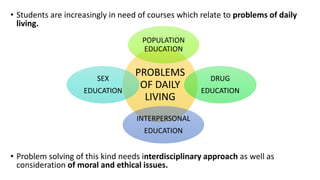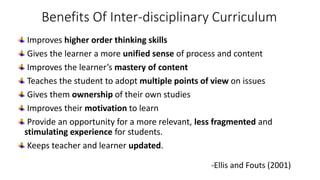interdisciplinarycurriculum
- 1. UNDERSTANDING DISCIPLINES AND SUBJECTS COURSE -5 ASSIGNMENT SUBMITTED BY: A. MAHASREE MEENAJAA (F17B044 ) I B.Ed GOVERNMENT COLLEGE OF EDUCATION FOR WOMEN COIMBATORE-01
- 3. OUTLINE • BASIC TERMINOLOGIES • TYPES OF DISCIPLINARY • INTER-DISPLINARY CURRICULUM • TWO PROBLEMS IN CONTENT SELECTION • INTER-DISPLINARY DEVELOPMENT PLANNING • GROWING NEEDS OF INTER-DISCIPLINARY CURRICULUM • BENEFITS OF INTER-DISCIPLINARY CURRICULUM
- 4. DISCIPLINE FIELD A specific body of teachable knowledge with its own background of education, training, procedures, methods, and content areas. PIAGET (1972) INTERDISCIPLINARY A knowledge view and curriculum approach that consciously applies methodology and language from more than one discipline to examine a central theme, issue, problem, topic, or experience. H.H. JACOBS (1989)
- 6. TYPES OF DISCIPLINARY 1. Intradisciplinary: working within a single discipline. 2. Crossdisciplinary: viewing one discipline from the perspective of another. 3. Multidisciplinary: people from different disciplines working together, each drawing on their disciplinary knowledge with no direct attempt to integrate . 4. Interdisciplinary: integrating knowledge and methods from different disciplines, using a real synthesis of approaches. 5. Transdisciplinary: creating a unity of intellectual frameworks beyond the disciplinary perspectives.
- 8. INTER-DISCIPLINARY CURRICULUM An inter-disciplinary curriculum combines several school subjects into one active plan or is organized to divide subject-matter lines, bringing together various aspects of the curriculum into meaningful association. It focuses on broad areas of study since that is how children meet subjects in the real world-combined in one activity.
- 9. Two problems in content selection of a curriculum The Potpourri Problem: Many units become a sampling of knowledge from each discipline. If the subject is Ancient Egypt, there will be a bit of history about Ancient Egypt, a bit of literature, a bit of the arts, and so forth. Hirsch and Bloom (1987) have criticized this approach for its lack of focus. Unlike the disciplines ,there is no general structure in interdisciplinary work. The Polarity Problem: Traditionally, interdisciplinarity and the discipline fields have been seen as an either/or polarity, which has promoted a range of conflicts. Not only does the curriculum design suffer from a lack of clarity, but real tensions can emerge among teachers. Some feel highly territorial about their subjects and are threatened as new views of their subject are promoted.
- 10. To avoid these two problems, effective interdisciplinary programs must meet TWO CRITERIA; They must have carefully conceived design features: a scope and sequence, a cognitive taxonomy to encourage thinking skills, behavioral indicators of attitudinal change, and a solid evaluation scheme. They must use both discipline-field-based and interdisciplinary experiences for students in the curriculum.
- 11. INTER-DISPLINARY DEVELOPMENT PLANNING i. Formulate a goal statement which indicated the principle or concept to be understood at the completion of the lesson. ii. Select the primary content base which will serve as the catalyst for the instruction. iii. Identify events, discoveries, and writings within other disciplines that relate to the primary content base in a meaningful way. iv. Determine the key points of intersection between the disciplines. v. Formulate instructional objectives vi. Identify the necessary prerequisite knowledge that students must posses in each discipline area. vii. Formulate instructional strategies which will compel students to use their knowledge.
- 12. GROWING NEEDS OF INTER DISCIPLINARY CURRICULUM • For a more inter-disciplinary approach in education is not a recent development, and has been advanced through a variety of arguments. Thereby to fulfill needs of the current situation and to prepare learner’s more adequately to shape and choose a future. • Each “discipline” look at the world from a particular view point , for a particular purpose. This makes students difficult to see the world as whole. • Hence there is need to develop broad understanding to operate successfully as a As a person As a citizen As a productive worker
- 13. • One of the important reason for looking into inter-disciplinary curriculum is that our present disciplines are older ways( tradition of EUROPE) of describing knowledge. Therefore developments of this new century are to be included. Eg: Space science, nano-technology , satellite monitoring etc • Need for emphasis on current situation which addresses different types of topic like environmental education, education and work, eductaion and world peace. • Enhancing the links between the subjects like history , literature, science, social science , mathematics and geography.
- 14. • Students are increasingly in need of courses which relate to problems of daily living. • Problem solving of this kind needs interdisciplinary approach as well as consideration of moral and ethical issues. PROBLEMS OF DAILY LIVING POPULATION EDUCATION DRUG EDUCATION SEX EDUCATION INTERPERSONAL EDUCATION
- 15. • The teachers should be active curriculum designers and determine the nature and degree of integration and the scope and sequence of study. • The teacher's decisions will most directly affect students in the day-to- day running of the classroom. The teacher should be empowered to work as a designer, to shape and to edit the curriculum according to the students' needs. • Curriculum making is a creative solution to a problem, hence,interdisciplinary curriculum should only be used when the problem reflects the need to overcome fragmentation, relevance, and the growth of knowledge.
- 17. • Students should have a range of curriculum experiences that reflects both a discipline-field and an interdisciplinary orientation as discussed earlier. students cannot fully benefit from interdisciplinary studies until they acquire a solid grounding in the various disciplines that interdisciplinarity attempts to bridge (Jacobs and Borland 1986). • Interdisciplinarity in social medicine and sociology of health emerged as an epistemological goal. • To enhance critical thinking ability and metacognitive skills, and an understanding of the relations among perspectives derived from different disciplines. • The challenges of the modern world require integrative problem solving and, at a more comprehensive level, holistic thought and transdisciplinary schema promote unity of knowledge.
- 19. Benefits Of Inter-disciplinary Curriculum Improves higher order thinking skills Gives the learner a more unified sense of process and content Improves the learner’s mastery of content Teaches the student to adopt multiple points of view on issues Gives them ownership of their own studies Improves their motivation to learn Provide an opportunity for a more relevant, less fragmented and stimulating experience for students. Keeps teacher and learner updated. -Ellis and Fouts (2001)
- 20. REFERENCE • TNTEU Course material • Understanding and disciplines and subject (book) by Dr.S. Suma J. Remi Hepsibha Dr. G. Periannan • Research papers on education • https://www.scribd.com/document/330080042/INTHEOPEN • http://www.arj.no/2012/03/12/disciplinarities-2/ • https://pdfs.semanticscholar.org/a356/a7d8086b5d85e7804b7d25d4215 20562309d.pdf • http://www.ascd.org/publications/books/61189156/chapters/The- Growing-Need-for-Interdisciplinary-Curriculum-Content.aspx




















